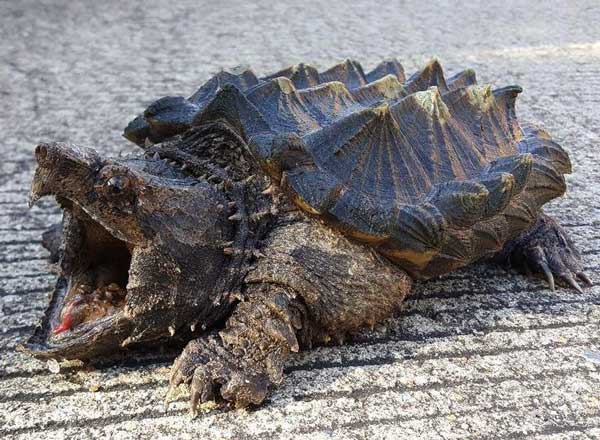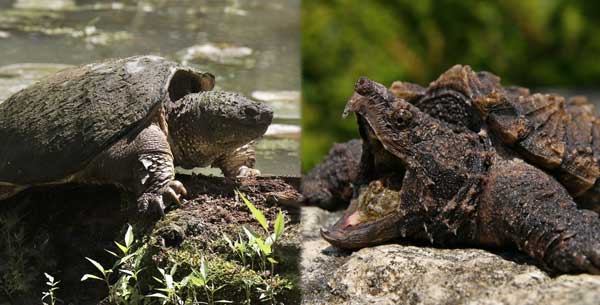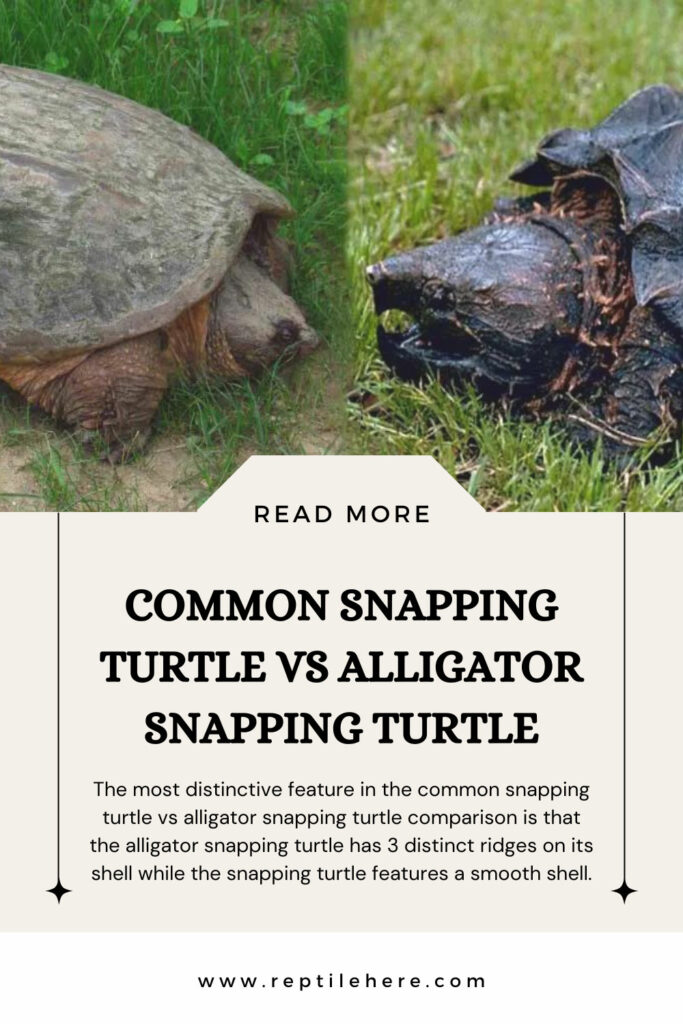Common Snapping Turtle vs Alligator Snapping Turtle
The common snapping turtle and alligator are often confused with one another. And it’s easy to see why—the two snapping turtle species belong to the same family and are distant cousins. However, these two turtles have distinct differences that set them apart.
The most distinctive feature in the common snapping turtle vs alligator snapping turtle comparison is that the alligator snapping turtle has 3 distinct ridges on its shell while the snapping turtle features a smooth shell.
Below, we’re going to compare the two snapping turtles side by side and outline their key differences. By the time we’re done reading this guide, you should be able to easily identify each of these snapping turtles when you see them.
Common Snapping Turtle vs Alligator Snapping Turtle Comparison Table:
Contents
| Common Snapping Turtle (Chelydra serpentine) | Alligator Snapping Turtle(Macrochelys temminckii) | |
| Appearance | Oval shaped head Smooth, rounded shell Long, serpentine neck | Triangular head Heavily ridged shell Hooked mouth |
| Size | Around 22 inches | Around 32 inches |
| Weight | 10 to 35 lbs. (Record weight: 75 lbs.) | 20 to 175 lbs. (Record weight: 249 lbs.) |
| Distribution | Freshwaters of Eastern US all the way to Rocky mountains, Central America, and Southern Canada spanning to the Gulf of Mexico | Freshwaters of Northern Florida, Iowa, Gulf of Mexico, East Georgia, and West Texas |
| Sexual maturity | 15 to 20 years | Around 12 years |
| Egg Clutch | Females lay up to 100 eggs | Females lay up to 50 eggs |
| Diet | Omnivorous | Carnivorous |
| Care Level | Intermediate level | Expert level |
| Cost | More affordable | Costly |
| Level of aggressiveness | Severe | Mild |
| Biting force | Approx. 160 Newton | Approx. 210 Newton |
| Speed | More mobile in water | Less mobility in water |
| Lifespan | 30 to 50 years | 50 to 100 years |
Common Snapping Turtle vs Alligator Snapping Turtle (Side by side comparison):
Below, we go into full details about how the two types of snapping turtles compare in various aspects including appearance, size, diet, lifespan, and so much more.

Physical appearance
The two turtles share a lot of physical similarities since they belong to the same family, and it’s not easy to tell them apart. However, there are certain distinct features you can use to identify each of them.
The alligator snapping turtle is known for its “pre-historic” looks and is often referred to as the “dinosaur of the turtle world.” It features up to 3 distinctive rides on its shell and a triangular head. It also has a red, wormlike lure in its mouth that enables it to easily catch its prey. The turtle has fleshy eyelashes around its eyes.
The common snapping turtle, on the other hand, has a smoother shell and an oval-shaped head. Unlike its cousin, it lacks a wormlike mouth lure and fleshy eyelashes around its eyes. Common snapping turtle also has a highly mobile neck and head, which is described as snakelike.
Size & weight
Another thing that sets the two turtles apart is the alligator snapping turtle vs common snapping turtle size and weight.
The alligator snapping turtles are the largest and heaviest of the two. They’re well known for their massive body sizes of up to 35 inches! They’re also extremely heavy and weigh hundreds of pounds, with the heaviest ever recorded being 249 pounds!

Common snapping turtles are smaller than their cousins and have an average size range of 22 inches. They’re also much lighter than alligator turtles, weighing between 10 and 35 pounds on average.
Natural habitat
Common snapping turtles are usually spotted on shallow ponds and streams. However, they can also be spotted in brackish waters, e.g. estuaries, from time to time. These turtles exhibit high aquatic life and they rarely bask in the wild.
Alligator snapping turtles prefer deep, fast-moving rivers. However, they’re also easily spotted in oxbow lakes once in a while. Or, you can find them in other water systems/ways that adjoin the rivers.

They have a restricted range since they mostly inhabit the river systems draining into the Northern Coast of Gulf of Mexico. These river systems go through central Florida, Eastern Texas, and extend all the way up to the far north in southern Iowa in Mississippi river basin.
Feeding
The common snapping turtles’ diet contains more vegetation than the alligator snapping turtles.
However, they’re omnivorous and will also eat animal flesh including various invertebrates, frogs, fish, reptiles, birds, and even small mammals. But they’ll prefer feeding on vegetation most of the days.
Alligator turtles have a more carnivorous inclined diet and prefer feeding on other animals. Their favorites include fish, amphibians, mollusks, and carrion.
They also like feeding on worms, water birds, crayfish, and even other turtles. They’re also opportunistic feeders and will eat both live and dead matter.
Common snapping turtle vs alligator snapping turtle as a pet
Snapping turtles generally don’t make good pets for average pet turtle lovers. They’re pretty big and require larger enclosures. They’re also dangerous to keep around and can live for many years.

If you still want to keep a snapping turtle for a pet, we suggest going with the common snapping turtle. This type has a smaller size and mild temperament, making it more practical to keep for a pet.
Baby Alligator snapping turtle vs baby common snapping turtle
Baby alligator and common snapping turtles have the same features as their adult counterparts. So, you can use our earlier descriptions for the adults to tell apart their young ones.

However, keep in mind that differentiating alligator snapping turtle vs common snapping turtle baby can be a bit challenging. The differences are hard to small for baby turtles, but they become more distinctive as they mature.
For instance, the dorsal ridges on common snapping turtles become smaller and eventually smoothen out as the turtle matures. The ridges on alligator turtles however remain throughout their lifespan.

Alligator snapping turtle vs common snapping turtle bite
The common snapping turtle has a higher bite force of up to 210 Newton while the alligator snapping turtle has a much smaller bite force of 160N.
Nevertheless, both snapping turtle species are well known for their strong jaws with extremely strong bites. Their bites are strong enough to break through bones, so you shouldn’t underestimate these turtle species!
The alligator snapping turtle can slice your fingers clean off or even prod a brand-new wooden broomstick!
The fact that they’re aggressive makes them a dangerous species of turtle to humans! The National Wildlife Federation even warns that you should never handle an alligator in the wild.
We found this interesting video of an alligator turtle taking a bite
Alligator snapping turtle vs common snapping turtle fight: Who would win?
We’ve previously discussed the aggressiveness and biting force associated with these two species of turtles. Now imagine a fight between these two turtles. Who do you think would win?
Since such an event has never occurred in real life, it would be impossible to judge which species will emerge as the winner. The winner will mainly depend on the condition of each turtle and circumstances surrounding the fight.
You should keep in mind that alligator snapping turtles are known to be less aggressive compared to the common snapping turtles. It’s considered one of the largest freshwater turtles, and its strong jaws plus large sharp claws make it heavily armored.

The common snapping turtle also has strong jaws plus sharp claws. But one weakness of this turtle is its small size compared to that of alligator turtle.
However, both turtles are quite aggressive and are capable of defending themselves from any threat, so it’d be hard to declare one as a winner over the other.
In perfect conditions, the alligator is likely to win this fight!
FAQs:
Yes! Common snapping turtles are known to be more aggressive than alligator turtles. This is especially true when they feel threatened or when searching for food. They’ll defend themselves or actively pursue prey using their sharp claws and powerful jaws. Nevertheless, both snapping turtles are quite aggressive and should be handled with care.
The alligator turtle is considered more dangerous than snapping turtles. However, both types of snapping turtles are considered dangerous if they feel threatened or if improperly handled. The snapping turtles are armed with powerful jaws and sharp claws that can easily inflict serious injuries on humans.
A common snapping turtle and alligator will not breed because they have different mating seasons and behaviors. They also live in completely different habitats and ranges, further making it impossible for them to breed. In the unlikely event that the two turtles mate, they’re high chances they won’t produce viable offspring.
Final Verdict
We hope that this article has answered your question on what is the difference between an alligator snapping turtle and a common snapping turtle. We have discussed how these two types of snapping turtles are compared alongside various aspects including appearance, size, diet, lifespan, natural habitat, potential predators, temperament, and hunting skill.
You can easily identify an alligator snapping turtle by its larger and heavier body, heavily ridged shell, red and wormlike mouth, and limited distribution range. Common snapping key characteristics include a smaller body than its cousin, a smoother shell, and a wider distribution range.


